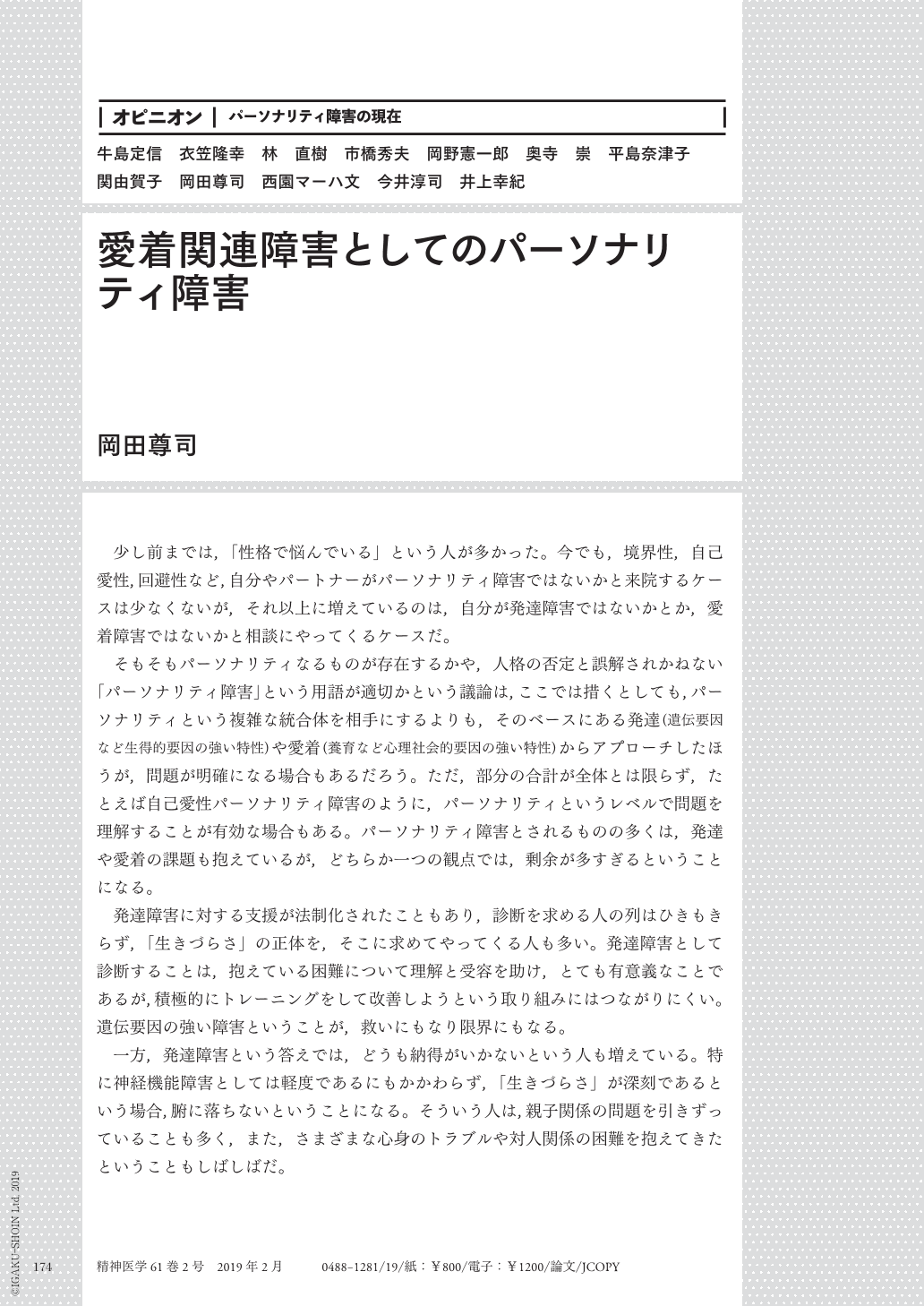1 0 0 0 OA 愛着関連障害と愛着アプローチ ―「医学モデル」から「愛着モデル」へのパラダイムシフト―
- 著者
- 岡田 尊司
- 出版者
- 一般社団法人 日本心身医学会
- 雑誌
- 心身医学 (ISSN:03850307)
- 巻号頁・発行日
- vol.62, no.5, pp.379-383, 2022 (Released:2022-09-01)
- 参考文献数
- 8
In recent decades, an increasing number of new psychotic and psychosomatic disorders have affected patients and therapists. These include chronic depression, borderline personality disorder, eating disorders, various types of addictions, dissociative disorders, ADHD, chronic pain disorders, and other psychosomatic disorders. All share a common feature ; they are all reportedly associated with insecure attachment and can be called “attachment-related disorders.” Attachment is physiologically based on the oxytocin system, and its dysfunction causes persistent and serious problems. According to the common medical model, doctors diagnose disease based on symptoms and alleviate symptoms by curing the disease. However, this model often fails in attachment-related disorders. This is because (1) people treated as patients are not always true patients ; (2) symptoms are not always true problems and offer shelters ; and (3) as symptoms and diagnoses change depending on the situation and developmental stage, the long lists of categorical diagnoses only confuse treatment. However, when one sees what is happening from the viewpoint of attachment, a clear understanding is gained. The fundamental problem underlying variable symptoms is dysfunction of the oxytocin system owing to damaged attachment. Therefore, it may be appropriate not to treat symptoms but improve insecure attachment, such as by improving the relationship with parental figures. I named this hypothesis “attachment model” and the treatment approach based on this model “attachment approach.”I have worked at the Kyoto Medical Training Center for Juvenile Delinquents for 20 years. Most inmates suffered insecure attachment, and difficulties doubled or tripled with psychotic and somatic diseases, amphetamine addiction, family problems, and crimes. However, the common medical approach was almost ineffective. Nevertheless, some patients overcame these difficulties and retrieved themselves by restoring their relationships with their parental figures.The aim of the attachment approach is to support parents as a safe base for their children and heal the damaged relationships between them. Counseling, cognitive work, skill training, and medications are sometimes applied to parents. This approach often causes significant changes. It is desirable to continue support even after a good relationship has been restored.Another attachment approach was developed for those who could not expect parental cooperation but wished to overcome insecure attachment by themselves. Programs composed of psychoeducation, cognitive and mentalization training, mindfulness, daily tasks, and homework were offered. Through step-by-step cognitive and practical exercises, the participants learned to observe things apart from their own viewpoints. Among the 93 patients who participated in more than ten sessions, 94% showed some improvement. However, there have been a few cases of deterioration. Although the evidence level is limited, considering the difficulty of these problems, this result provides hope.
1 0 0 0 OA パーソナリティ障害の時代(人格とは何か-パーソナリテイ障害の時代を考える-)
- 著者
- 岡田 尊司
- 出版者
- 日本医学哲学・倫理学会
- 雑誌
- 医学哲学 医学倫理 (ISSN:02896427)
- 巻号頁・発行日
- vol.24, pp.101-105, 2006-10-24 (Released:2018-02-01)
1 0 0 0 愛着関連障害としてのパーソナリティ障害
少し前までは,「性格で悩んでいる」という人が多かった。今でも,境界性,自己愛性,回避性など,自分やパートナーがパーソナリティ障害ではないかと来院するケースは少なくないが,それ以上に増えているのは,自分が発達障害ではないかとか,愛着障害ではないかと相談にやってくるケースだ。 そもそもパーソナリティなるものが存在するかや,人格の否定と誤解されかねない「パーソナリティ障害」という用語が適切かという議論は,ここでは措くとしても,パーソナリティという複雑な統合体を相手にするよりも,そのベースにある発達(遺伝要因など生得的要因の強い特性)や愛着(養育など心理社会的要因の強い特性)からアプローチしたほうが,問題が明確になる場合もあるだろう。ただ,部分の合計が全体とは限らず,たとえば自己愛性パーソナリティ障害のように,パーソナリティというレベルで問題を理解することが有効な場合もある。パーソナリティ障害とされるものの多くは,発達や愛着の課題も抱えているが,どちらか一つの観点では,剰余が多すぎるということになる。



